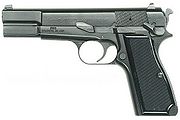Handgun
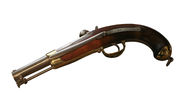

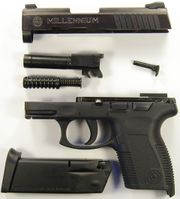
A handgun is a firearm designed to be held and operated by one hand, with the other hand optionally supporting the shooting hand. This characteristic differentiates handguns as a general class of firearms from their larger counterparts: long guns such as rifles and shotguns (which are held in both hands and usually braced against the shoulder), mounted weapons such as machine guns and autocannons, and larger weapons such as artillery.
Some handgun subtypes include derringers, single-shot pistols, revolvers, semi-automatic pistols, pepperboxes, and machine pistols. The overlapping variations in meaning of the words "pistol" and "handgun" are discussed below.
Contents |
Nomenclature variations
Multiple senses of the word "pistol"
The word "pistol" is often synonymous with the word "handgun". Some handgun experts make a technical distinction that views pistols as a subset of handguns. Sometimes in American usage, the term "pistol" refers to a handgun whose chamber is integral with the barrel, making pistols distinct from the other main type of handgun, the revolver, which has a revolving cylinder containing multiple chambers. However, Commonwealth usage makes no distinction at a technical level—"pistol" may refer to revolvers, semi-automatics, or muzzle-loading/cap-&-ball handguns. For example, the official designation of the Webley Mk VI was "Pistol, Revolver, Webley No. 1 Mk VI", and the designation "Pistol No. 2 Mk I" was used to refer to both the Enfield Revolver and the later Browning Hi-Power semi-automatic.[1][2][3][4]
The first pistols were made as early as the 15th century, but their creator is unknown.[5] By the 18th century, the term came to be used often to refer to handheld firearms. Practical revolver designs appeared in the 19th century, and it was in that century that the (sometimes-observed) technical differentiation in usage from the words "pistol" and "revolver" developed, at that time differentiating the newer revolver from the single-shot pistols previously in use.
Etymology of "pistol"
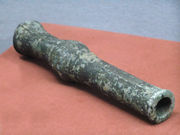
The word "pistol" is derived from the French pistole (or pistolet), which has these possible origins:
- From the Czech pistole and this one from the Czech píšťala (flute or pipe, referring to the shape of a Hussite firearm), from Middle High German pischulle or from Middle French pistole.
- From the city of Pistoia, Italy, where hand-held guns (designed to be fired from horseback) were first produced in the 1540s.[6]
- That early pistols were carried by cavalry in holsters hung from the pommel (or pistallo in medieval French) of a horse's saddle.
Types of handguns
The general types of handguns are listed below in their order of historical appearance. Each type can be classified into many subtypes. Some of these types can also be differently classified using the general distinction between muzzle-loading firearms (loading from the front of the barrel) and breech-loading firearms (loading from behind the barrel).
Single-shot pistols

Single-shot pistols are theoretically the simplest pistols. The earliest handguns were single-shot, muzzle-loading guns with ignition provided by inserting a smoldering match cord into a touch hole. As such, they were essentially nothing more than miniature cannons, small enough to be handheld.
Improvements followed in subsequent centuries, as various types of locks (ignition devices) were invented. In the matchlock, the separate match cord was affixed to a spring-loaded pivot which could be tripped by a trigger. In the wheellock, a mechanism analogous to that used in today's cigarette lighters replaced the smoldering match cord. In the 17th century, the flintlock, which strikes a flint against steel, appeared. (The flintlock, amazingly, remained state-of-the-art for some two hundred years.) In the 19th century, percussion caps were developed, followed shortly by modern integrated-primer cartridges, and hammers therefore traded their flint for firing pins.
Single-shot pistols continue to be manufactured today and are often used for handgun hunting game, including big game. The most powerful handguns are capable of taking all game including elephant.
Multi-barreled pistols
Not long after the very beginning of firearms, inventors began experimenting with multi-barreled weapons in the quest for the ability to fire more than one shot before needing to reload. Not surprisingly, all types of firearms were included in their efforts, from volley guns to analogously devised handguns. Before anyone had developed a practical capability for delivering multiple loads to one barrel in quick succession (which is how repeating fire is usually accomplished today), gun smiths were aggregating multiple loaded barrels into one place.
Some examples of multi-barreled pistols are:
- Duck's-foot pistols
- Derringers
- Pepper-box guns (variously referred to as pepper-box pistols or pepper-box revolvers)
- Howdah pistols, often made from double-barrelled rifles.
Revolvers
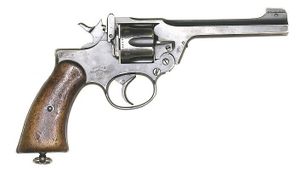
With the development of the revolver in the 19th century, gunsmiths had finally achieved the goal of a practical capability for delivering multiple loads to one handgun barrel in quick succession. Revolvers feed ammunition via the rotation of a cartridge-filled cylinder, in which each cartridge is contained in its own ignition chamber, and is sequentially brought into alignment with the weapon's barrel by a mechanism linked to the weapon's trigger (double-action) or its hammer (single-action). These nominally cylindrical chambers, usually numbering between five and eight depending on the size of the revolver and the size of the cartridge being fired, are bored through the cylinder so that their axes are parallel to the cylinder's axis of rotation; thus, as the cylinder rotates, the chambers revolve about the cylinder's axis.
There is a hybrid form of the revolver, known as the automatic revolver, which combines the revolving chamber concept of the conventional revolver with the recoil-harnessing, self-cycling ability of the semi-automatic pistol. Weapons of this type are rare, as the technology was quickly rendered obsolete by a combination of the double-action revolver and the semi-automatic pistol.
Lever action pistols
The first lever action pistols were based on a Horace Smith and Daniel B. Wesson patent of 1854. The Smith & Wesson pistols were made in Norwich, Connecticut 1854-55. In 1855, Oliver F. Winchester became an active investor and H. Smith and D.B. Wesson both dropped out of the enterprise. In July 1855, the name was changed to Volcanic Repeating Arms Company, and later to New Haven Arms Company, opening an important chapter in Winchester's history. The production of the Volcanic pistols lasted until 1860. Two models were produced: The Navy Pistol .41 cal. with 6" / 8" / 16 " barrels and a Pocket Pistol .31 cal. with 3½" / 6" barrels.
Semi-automatic pistols
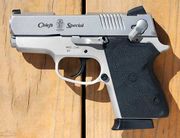
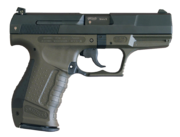

The next development in handgun history after a practical revolver was the development of the semi-automatic pistol, which uses the energy of one shot to reload the chamber for the next. Typically recoil energy from a fired round is mechanically harnessed; however, larger calibers may also be gas operated (e.g. Desert Eagle). After a round is fired, the pistol will cycle, ejecting the spent casing and chambering a new round from the magazine, allowing another shot to take place immediately.
Some terms that have been, or still are, used as synonyms for "semi-automatic pistol" are automatic pistol, autopistol, autoloader, self-loading pistol and selfloader.
Machine pistols
A machine pistol is generally defined as a firearm designed to be fired with one hand, and capable of fully automatic or selective fire. While there are a number of machine pistols such as the Glock 18 and later models of the Mauser C96, these are rare; the light weight, small size, and extremely rapid rates of fire of a machine pistol make them difficult to control, making the larger and heavier submachine gun a better choice in cases where the small size of a machine pistol is not needed. Most machine pistols can attach a shoulder stock (the Heckler & Koch VP70 would only fire single rounds at a time unless the stock was attached); others, such as the Beretta 93R, add a forward handgrip. Either of these additions technically create a legal non-pistol under the US National Firearms Act, as pistols are by definition designed to be fired with one hand. The addition of a stock or forward handgrip is considered a design change that creates either a short-barreled rifle or any other weapon, and therefore such additions are generally only found on legal machine guns.
Operating mechanisms

Single-action handguns have a trigger whose sole function is to drop a pre-cocked hammer to discharge a cartridge. For revolvers, the popular Colt Peacemaker of Old West fame is typically thought of. Its hammer must be manually cocked for each shot. For auto-loading pistols the Colt 1911 or Browning Hi-Power are typical examples. They must be cocked for the first shot, but subsequent shots are cocked automatically due to the racking of the slide. These types of guns typically have a very light and crisp trigger pull, making for more accurate target shooting.
Traditional double-action handguns have a mechanism that can be either pre-cocked, like the above single-action gun, or can be fired with the gun uncocked. In this case, the gun has an additional mechanism added to the trigger that will cock the gun (and rotate the cylinder in the case of revolvers) as the trigger is pulled. Once the trigger is pulled far enough, the hammer is released and the gun fired. For autoloading pistols the self-loading mechanism will also re-cock the hammer after the first shot is fired so that subsequent shots are fired single-action. For revolvers, each shot is fired with the hammer initially uncocked unless the shooter manually cocked the gun. Popular auto pistols in this category include the Walther P38 and Beretta 92. These guns typically have a longer, heavier trigger pull for the first shot then light, crisp pulls for subsequent shots. Popular revolvers include the Ruger Redhawk and Smith & Wesson Model 29. These have comparatively long, heavy trigger pulls for all shots unless the revolver is manually cocked.
Double-action only handguns do not have the ability to be cocked and is usually evidenced by a lack of either the hammer spur or the entire hammer. A typical autopistol in this category is the Ruger KP93DAO and a typical revolver is the Smith & Wesson Centennial or the Enfield No 2 Mk I*. All pistols in this category have a long, heavy trigger pull for all shots.
Pre-set triggers are only on autoloading pistols. In this case the pistol mechanism is always partially cocked while being carried and during firing. The partially cocked firing pin or striker is not cocked enough to cause an accidental release to discharge a cartridge, adding to the safeness of the design, but is cocked enough to remove much of the trigger pull and weight of a purely double-action pistol. These types of pistols do not have external hammers and do not generally have a decock function. Common pistols in the category are the HS2000 (Springfield XD) and the various forms of the extremely popular Glock. The trigger pull of these guns is between double-action and single-action pistols. Pre-set triggers may or may not have a second-strike feature on a dud cartridge.
Some automatic pistol models such as the HK USP Universal Self-loading Pistol (or U.S.P.) come in a variety of mechanism types and can be easily changed by a gunsmith for both left- and right-handed shooters and for different operating mechanism and safety features.
Glock introduced a new "Safe Action" mechanism that is neither a single nor double action.[7] The weapon is never "cocked" in terms of a hammer being "cocked". The partly tensioned firing pin lock is released by pressing the trigger, resulting in the first and subsequent trigger pulls all being the same.
Semi-automatic pistols vs. revolvers
Both revolvers and semi-automatic pistols have prominent places in the world of handgun applications today. For over a century, however, a debate has continued as to which one is better for which particular application and why. Each has its place, although personal preference is as large a factor as the following variables:
- Reliability (likelihood of malfunctions; how to recover from malfunctions; how to recover from misfires)
- Degree of user training needed
- Degree and frequency of gun cleaning needed
- Ammunition capacity
- Speed and ease of reloading
- Bulkiness with regard to concealment
- Weight
- Center of gravity
- Storage issues
Advantages of revolvers
- Ease of use: Most revolvers have no external safety devices which need to be deactivated before firing nor do they require manual cocking, making revolvers quicker and simpler to put into action. All semi-automatics require manually cocking the slide before firing, and many also have manual safeties which must be disengaged before firing.
- Reliability: Revolvers are mechanically simpler and contain fewer parts than semi-automatics so are less likely to suffer stoppages or malfunctions.
- In a double action revolver, a dud round can be cleared with a simple pull of the trigger. In the case of single action semi-automatics, the hammer, if one is present, must be re-cocked in order to re-strike a dud round or the slide racked to remove it. Many double action semi-automatics can re-strike a dud round simply by pulling the trigger, but as with single actions, the slide must be racked otherwise.
- Potential for greater stopping power: The largest and most powerful handgun cartridges are designed for revolvers, owing to their more robust design.
- Revolvers will easily fire blank ammunition. Most semi-automatics will not fully cycle with blank cartridges, causing malfunctions. Semi-automatics must be specially modified to properly cycle with blank ammunition. This modification renders them incapable of firing other types of ammunition.
- Spent cartridges are kept in the cylinder making them easier to retrieve for hand reloading or clean-up. Semi-automatics eject cartridges some distance, requiring them to be retrieved for hand loading or clean-up.
- Greater variety of ammunition: Revolvers can handle a wider variety of bullets, including wadcutters, which will malfunction in most semi-automatics. Wadcutters are designed for target practice, making revolvers more appealing to many sporting shooters.
- Multiple calibers: Many revolvers can load certain interchangeable cartridges, those with identical bore diameters but different case lengths. Interchangeable cartridges include .22 short/long/long rifle, .357 magnum/.38 special, .44 magnum/.44 special, and .45 Colt/.410 shotshells. Note: Please check with the manufacturer.
- Greater accuracy: Sights are mounted to a fixed barrel, theoretically allowing greater accuracy.
- Easier to determine if loaded: In most revolvers, the cartidges are readily apparent when loaded. An unloaded semi-automatic is often visually identical to a loaded one.
- Easier to clean and maintain: Revolvers have few exposed moving pieces and do not require disassembly. There is no risk of loss or breakage of pieces when cleaning a revolver. Semi-automatics must be disassembled for cleaning, which may be difficult and risks losing or breaking vital pieces in the field or in darkness.
Advantages of semi-automatics
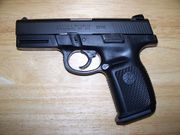
- Larger ammunition capacity: semi-automatics typically carry around 7 to 20 rounds; whilst most revolvers carry between 5 and 8 rounds. Magazines are limited to 10 round capacity in some jurisdictions, such as California, largely negating this advantage in those jurisdictions.
- Compact ammo storage: The flat shape of most magazines make them more convenient to carry than the speedloaders needed for revolvers.
- Slimmer profile: Semi-automatics often have a significantly slimmer and easier to conceal frame as they do not suffer from the bulge produced by cylinder of a revolver.
- Lighter: Some modern semi-automatics have frames made of polymers, making them lighter and more comfortable to carry for long periods. Recent advancements in technology and design major manufacturers are producing polymer frame revolvers like the Ruger LCR, Smith & Wesson Bodyguard 38, and Taurus Protector Polymer that rivals the weight of polymer semi-automatics.
- Safety: Some semi-automatics incorporate an external safety switch, which prevents the gun from firing. Most revolvers do not have such a feature, though the same is true of many semi-automatics. There is debate over whether external safety switches are necessary, particularly in models with trigger-activated firing pin blocks, though many users prefer them for peace of mind regardless of whether or not they are safer.
- Quieter: With similar ammunition, a semi-automatic is typically slightly quieter. Flash and noise can be suppressed. Noise and flash suppressors are ineffective in most revolvers due to noise and flash escaping the gap between the cylinder and the barrel. Suppressors are illegal in many jurisdictions.
- Less expensive ammunition: semi-automatics often fire standard military ammunition, which is more readily available and cheaper thanks to extensive mass production. However, some revolver cartridges such as .38 Special are comparable in their cost and availability to popular autoloading cartridges such as 9mm Parabellum and .45 ACP.
Advantages of handguns versus shoulder firearms
In comparison to long guns (rifles and shotguns), handguns are smaller, lighter, and easier to carry. Since firearms do not rely entirely on the user's strength, they put weaker individuals on an equal defensive footing; when Colt produced the first practical repeating handgun, it gave rise to the saying "God created men, but Colt made them equal".[8],[9]
Since using a handgun, at a minimum, requires one hand whereas long guns often require both, that leaves a handgun user with a free hand. One example of where this is an advantage is with tactical lights, where the light and handgun can be used independently or in coordination; mounted lights, as used on long guns and submachine guns, don't allow the light to be pointed independently of the firearm. In addition, handguns can be more easily used ambidextrously, and therefore the user can switch firing hands depending on the situation.
Another important tactical consideration in the context of civilian self-defense is maneuverability. An attacker in close quarters with the defender could more easily wrestle a long gun's muzzle to a position where it is not covering him, or could more easily wrestle the gun away from the defender, whereas a handgun offers little to grab, and would be more likely to still be covering some portion of the attacker during the struggle.[10]
Disadvantages of handguns versus shoulder firearms
Handguns are often considered self-defense weapons for use under 50 yards (46 m). While a handgun in the hands of an experienced shooter may be effective at distances greater than 50 yards (46 m), a handgun cartridge is much more limited in its energy capacity than many long gun cartridges. Many handgun cartridges are optimized for best performance[11] from shorter barrels than typically found in rifles.
Many rifles are able to achieve bullet velocities of over 3,000 feet (914 m) per second, but rounds for handguns are rarely capable of achieving velocities over 1,500 feet (457 m) per second. Thus, long guns are generally more powerful at any range, and especially more effective at longer ranges than handguns.
A shooter is generally able to achieve considerably greater accuracy with a long gun than with a handgun. This is due partly to the longer distance between the rear and front sights, partly due to a more stable hold attainable with a long gun, and partly due to the higher muzzle velocity, which reduces the bullet travel time and thus reduces external effects on the bullet such as gravitational drop and wind.
Handguns and gun politics
Many handgun models are easily concealed on a person—a trait that is useful both to people wishing to bear arms for self-protection and to criminals wishing to carry a handgun for illegal purposes. For these reasons, handguns are a particular focus of debates on gun politics, and in many jurisdictions both keeping and bearing them is much more heavily regulated than with long guns.
Australia
Civilian ownership of handguns in Australia is legal, but heavily restricted. Handguns may not be owned for self-defense purposes (Target shooting, collecting, and occupational reasons for farmers/gun dealers are, by and large, the only legal reasons for handgun ownership), and anyone wishing to possess a handgun must obtain a firearms license and observe stringent storage regulations.
Canada
In Canada, ownership of handguns is restricted and subject to registration. Guns with a barrel length of 105 mm (about 4.14 inches) or less and handguns that fire .25 or .32 caliber ammunition are classified as prohibited. Some users are allowed to possess a handgun or rifle classified as prohibited (automatic and certain semi automatic firearms) if the firearm was owned and registered before the law came into effect on December 1, 1998.[12] A Possession and Acquisition or a Possession Only Licence is required to own all firearms. Permits to carry concealed weapons are rarely, if ever, granted to non-law enforcement personnel.[13]
Czech republic
It it possible to buy and own a gun for collecting, sporting, gamekeeping, occupation (private security, money transport) and self-defense purposes. Unlike most countries in Europe, in the Czech republic right to carry a concealed handgun is a natural part of self-defense gun license owner, after formal approval (no justification is needed) is written in the gun license.
Israel
In Israel, handguns are the only type of firearms that most private citizens may own. They are licensed for self-defense purposes to eligible individuals. Current regulations limit licenses to one handgun and 50 cartridges per licensee. Few places are off limits to handguns in Israel. Carrying of loaded handguns, openly or concealed, is slightly more common than other countries.
Italy
In Italy, private ownership of handguns is legal and allowed under any gun license, as for any other firearm; as such, handguns can be purchased by all individuals who hold a gun license of any kind, even a hunting license, although handgun hunting is not allowed in Italy. The law imposes limits to the number of handguns that can be owned, according to their destination of use: the maximum limit is three handguns listed as "Common firearms" (those normally employable for self-defense and other uses) and up to six handguns listed as "Sporting firearms" (those specifically engineered and manufactured for target competitions). Owners of handguns, and any other firearm, under a collector's license may exceed limits and own an unlimited number of handguns, but may not own ammunition for them and may not use them under any situation.
The concealed carry of a handgun for personal defense purposes is instead illegal unless the individual is granted a specific license (Porto d'armi per difesa personale, "Self-Defense firearms carry license") which is extremely hard to obtain and is released only to those who can demonstrate to have a justified reason, and a factual and underogable need, to carry a concealed firearm for self-defense; such license has to be renewed yearly, whereas all other gun licenses, which allow the purchase, ownership and transport, yet not the carry, of handguns, have a 5-years or 6-years expiry date. Owners of handguns under any other license than a concealed carry license are allowed to detain the firearm at home or in any of their premises for property defense, or to transport it unloaded, locked in a container and possibly partially stripped, to a shooting range or to any other location where target practice or recreational shooting can be safely practiced, but are not allowed to carry their firearm for self-defense, either open or concealed, nor to keep it loaded for any reason in any place other than their home or any of their premises, or outside of an authorized shooting range.
Some individuals, such as magistrates and high-rank military and Law Enforcement officials, don't need a license to privately procure and carry a concealed handgun for self-defense; Police officers under such high ranks are authorized to carry their service pistol off-duty, with their Police ID being the sole document needed, while they need a standard Concealed Carry license for the off-duty carry of non-issue firearm (on-duty carry of non-issue firearms is illegal for Police personnel in Italy); it should be noted anyway that even Police personnel is seldom, if ever, granted a Concealed Carry license, they are generally considered to "not need" it, being authorized to carry to the off-duty of their issue handgun.
Private security personnel is generally issued a 2-years-valid license allowing to carry firearms (both handguns and long guns) for service and self-defense, authorizing also open carry, which is otherwise forbidden to civilians in the Country.
Kenya
In Kenya, private ownership of certain types of firearms and ammunition is legal under the firearms act (cap. 114, laws of Kenya. Applicants for a gun owner’s licence in Kenya are required by law to show genuine reason for wanting to possess a firearm; such reasons may be for intance to use the firearm in target shooting, for protection or for personal security. Anyone as young as 12 can actually apply for gun ownership under the aforementioned Kenyan law. However, an applicant for a firearm licence must pass stringent background checks which consider criminal, mental and domestic violence records before he or she can be permitted to privately own a firearm and ammunition. Where a past history, or apprehended likelihood of family violence exists, the law stipulates that a gun licence should be denied or revoked hencewith. Additionally, the law further requires that any possession, sale or transfer of a firearm be recorded and retained in a centralised and official register managed by the Kenya Police. Moreover, the firearm regulations in Kenya spell out the written specifications for the lawful safe storage of private firearms and ammunition by all licensed gun owners. The regulations also specicify how such firearms and ammunition may be handled whilst on transit. As for carrying a concealed handgun in a public place, the law does not require one to have a permit to do so.
Pakistan
In Pakistan, citizens in the states of Punjab and Sindh are subject to strict gun control regulations and may only carry a concealed gun, even if it is with a bodyguard. Display of armory in public is banned, with fines of up to 50,000 Rupees. Citizens must also register guns and obtain licenses for them. In addition, for concealed carry, permits are also required which are issued separately by the home ministry of each province. Banned weapons are called prohibited bore weapons which are calibers above 0.44 in handguns and 0.222 in rifles plus all automatic weapons. Licenses are issued for these in specific circumstances but only by the approval of the Prime Minister of Pakistan.
United Kingdom
In the United Kingdom (with the exception of Northern Ireland), civilian ownership of almost any handgun has been outlawed since the Dunblane massacre of 1996; the only exclusions were single shot, rimfire, and muzzleloading pistols/revolvers. So called "Long Barreled" cartridge firing revolvers and semi automatic pistols (.22LR only) are still legal providing that they meet the following requirements: overall length not less than 24", barrel length not less than 12". As with all other legal firearms in the UK, possession requires a Firearm Certificate. The application and vetting process is carried out by the local police force and is very in depth. Good reason (justification) for holding a firearm certificate in the UK would be Target shooting (as part of a Home Office Approved Club) or hunting. "Self Defense" or other reasons of this nature are not allowed. The open carrying of any firearm in a public place is illegal in the UK. Concealed carry of any firearm in a public place would normally be illegal, unless authorised by the courts. Air pistols are still legal, however, those with energy levels over 6 foot pounds (8.1 joules) (half the limit for air rifles) are classified as firearms.[14][15][16]
United States of America
- See also: Gun laws in the United States (by state), Gun politics in the United States, Concealed carry in the United States
In the United States, the right of citizens to own a handgun is well-established. The rules for carrying a handgun in public vary by local jurisdiction. While there are many exceptions, in general open carry is allowed, but concealed carry requires a permit. Some states place certain restrictions on who may purchase handguns, and some have waiting periods after purchase. Anyone selling handguns at retail must have a Federal Firearms License, in addition to any local requirements.[17]
See also
- Firearm action
- Open carry
- Concealed carry
- Gun
- Pistol-whipping
- Handgun effectiveness
- Machine-pistol
- Pocket pistol
- Small arms
- Semi-automatic pistol
- Antique guns
- Target shooting
- Gunspinning
- Weapon
- List of pistols
- Handgun hunting
References
- ↑ Stamps, Mark; Skennerton, Ian (1993). .380 Enfield Revolver No. 2. London: Greenhill Books. ISBN 1-85367-139-8.
- ↑ Maze, Robert J (2002). Howdah to High Power. Tucson, AZ, USA: Excalibur Publications. ISBN 1-880677-17-2.
- ↑ Skennerton, Ian (1997). Small Arms Identification Series No. 9: .455 Pistol, Revolver No 1 Mk VI. Gold Coast, QLD, Australia: Arms & Militaria Press. ISBN 0-949749-30-3.
- ↑ Smith, W.H.B. (1979). 1943 Basic Manual of Military Small Arms (Facsimile). Harrisburg, PA, USA: Stackpole Books. ISBN 0-8117-1699-6.
- ↑ "Pistol, Britannica.com". http://www.britannica.com/eb/article-9060197/pistol.
- ↑ The War Office (UK): Textbook of Small Arms (1929)', page 86. H.M. Stationery Office (UK), 1929.
- ↑ "Glock Pistols". August 20, 2003. http://www.alpharubicon.com/leo/glockpistols.htm. Retrieved 2007-10-31.
- ↑ Cary, Lucian (1961) (Fawcett Book 447). The Colt GunBook. Greenwich, CT, USA: Fawcett Publications. pp. 3.
- ↑ Hosley, William (1999). "Guns, Gun Culture, and the Peddling of Dreams". In Robert Merrill Muth, Jan E. Dizard, Stephen P. Andrews. Guns in America: A Reader. New York: NYU Press. pp. 47. ISBN 0-8147-1879-5.
- ↑ Ayoob, Massad F. (1983). The Truth About Self-Protection. Originally published by Police Bookshelf, Concord, New Hampshire. Republished by Bantam Books.. pp. 333. ISBN 0-936279-13-3.
- ↑ Ballistics By The Inch
- ↑ RCMP fact sheets on firearms
- ↑ Canadian Firearms Centre paper comparing Canadian and American gun laws
- ↑ United Kingdom Air Rifle Law & Safety Reference
- ↑ Safety and the Law in the U.K.
- ↑ Air Rifles Code of Practice (revised July 2007)
- ↑ NRA-ILA Compendium of State Firearms Laws
External links
- Interactive Illustrated Pistol
- The story of pistols
- Handgun Database
- Handgun Database Video and Review
- Ballistics By The Inch - Relationship between barrel length and bullet velocity.
